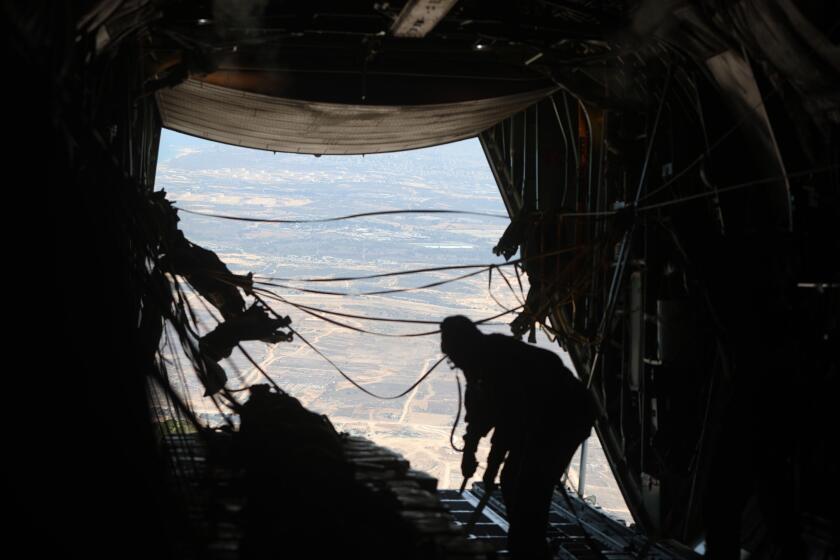The Jordanian air force C-130 Hercules cargo plane banked in a slow arc over the Mediterranean, pointing its nose toward Gaza for its approach — the final stage of the intricate ballet that is dropping aid over the war-ravaged enclave.
Earlier, in a cavernous hangar at a Royal Jordanian Air Force base, soldiers from Jordan, Germany, Belgium, the Netherlands, United Arab Emirates and Singapore assembled to prepare the 79 tons of rice, sugar, pasta, tomato paste, dates and other basic foodstuffs set for the day’s drop.
Despite the sweltering heat, the soldiers stationed at King Abdullah II Air Base worked quickly, the hangar an ants’ nest of activity as they secured 1-ton piles of aid boxes to pallets, wrapped them in protective fabric, then tightened the rigging before using a forklift to hoist a parachute above each one.
No less active were the crews of the seven dark-gray C-130s arrayed on the tarmac nearby, their bellies open as loadmasters prepared the planes for their cargo.
“We have to get a 100% success rate for the drops,” said Phille, a Belgian soldier whose tattoos, muscular build and clean-shaven head belied the gentle way he spoke as he tied a low-velocity parachute to a pallet. He gave his nickname, in line with the Belgian military’s policy.
“Everyone works in a chain, and knows exactly what they need to do,” he said.
Despite all that effort, everyone at the base that day knew that the multinational air bridge to Gaza was a wildly inefficient solution to a problem that by rights should never have existed.
Since March, Israel has kept the enclave under a near-total blockade, justifying the move as necessary to prevent aid from benefiting Hamas. The United Nations, dozens of aid organizations and Western officials have all rejected that claim and accuse Israel of deliberately starving the enclave’s 2.1 million people.
In May, Israel created, with U.S. assistance, the Gaza Humanitarian Foundation and charged it with delivering aid to Gaza. Aid groups and governments have excoriated the GHF’s efforts as paltry, inefficient and haphazard.
GHF’s distribution methods, denounced as poorly planned and executed, have almost always turned deadly as Gazans trying to secure aid have died in the chaos or come under fire from Israeli forces.
Read more: ‘Death race’ for food: Hundreds killed in Gaza aid chaos
Health authorities in the Strip say more than 1,800 people have been killed near GHF sites, with rights groups describing the GHF’s methods as “orchestrated killing.” Israel and the U.S. insist the GHF is working.
In the face of blistering international pressure and daily reports of deaths from starvation — aid groups said this week that more than 100 children have died from malnourishment — Israel allowed airdrops to resume last month.
A number of world governments have signed on for air deliveries, their thinking being that some aid entering Gaza is better than nothing. But humanitarians generally view the drops as a last resort. The U.N. and aid groups say the best option is overland — a tried-and-true method that before the war brought 500 truckloads into the Strip per day from Jordan and Egypt.
The contrast with air deliveries is stark. A truck carries 25 tons, but planes can handle only a little more than half that amount, and even less in the case of hot weather due to strain on the engines.
Cost is another issue: Operating a C-130 cargo plane — the most common type of aircraft in the Gaza airlift — amounts to roughly $15,000 per hour of flight. A truck costs a fraction of that. The result is that an average food delivery by truck costs $180 per ton, while airdropping is a whopping $16,000 per ton, according to a U.S. Air Force study from 2016.
This isn’t aid. It’s chaos
Nasra al-Rash, Gaza Strip resident
Once the 18 pallets were loaded, the C-130 heaved itself into the air, then circled lazily over Amman, the Jordanian capital, while the pilots waited for Israeli authorities to coordinate their entry into Gazan airspace.
Roughly 30 minutes later, the plane headed southwest toward Tel Aviv — the cue for the crew to secure the pallets to the long steel cables running along the body of the C-130 that would deploy the chutes once dropped. Loadmaster Mohammad clipped a line to the cable, then secured himself and waited for the green light as the plane flew over the Mediterranean and positioned itself for the flight somewhere over central Gaza and lowered its altitude to 1,500 feet.
“Ten minutes to drop,” the loadmaster said.
The C-130’s cargo doors yawned open, letting in a rush of sea air before Gaza came into view. Moments later, it emerged as a landscape denuded of all color save brown and gray and the occasional red-rimmed maw of a destroyed brick rooftop. Almost every structure appeared damaged or in ruins.
Read more: Israel’s military says airdrops of aid will begin in Gaza amid warnings of famine
It was a sobering sight. Though all of the crewmen had seen it many times — Jordan alone has run more than 150 airdrops since July — they pressed their faces to the windows to glimpse the devastated landscape.
Dropping the aid is a delicate process. The attached parachutes have no GPS guidance systems, and though the pallets descend at a relatively slow 5 meters per second, their weight — 1 ton in most cases — makes them potentially lethal. This weekend in central Gaza, 14-year-old Muhannad Eid was crushed by an aid pallet as he ran toward it.
“We have to perform the airdrop as a surprise, so people don’t gather below,” Phille said earlier. “If we see people under the plane, we don’t give the green light.”
When the signal came, one line of pallets raced down the hold’s railing, their chutes ripping open in a flurry of motion as they fell out of the back, one after another. The sound of the engines increased as the pilot climbed higher and swung his way toward the King Abdullah II Air Base once more.
The parachutes floated down toward the coastline, not far from a cluster of makeshift tents, grapevines, fig trees and the outer edge of residential buildings.
Waiting for them on the ground was a group of men and boys. Once they saw the parachutes’ bloom, they sprinted toward the landing site. One of the pallets smashed onto the roof of a building. The rest settled nearby.
That building was private property, but some of the men rapidly scaled the walls. Two reached the roof, cut the parachute cords and dragged down supplies. They divided them. Minutes later, they each walked away, carrying small shares.
Not far from there, in al-Amer tent camp, dozens of families — about 50 in total — watched in despair.
“I’m an old man with 10 children and grandkids. What can these airdrops do for us? The poor, the elderly — they get nothing,” said Mutlaq Qreishi, a 71-year-old man displaced from the al-Zaytoun neighborhood of Gaza City, tears streaking down his face.
“It’s only the strong ones, the looters,” he added. “Every time I try, I can’t make it. My wife just wants tea, some milk — anything from a can. Look at that pallet — it fell in someone’s yard. People are fighting over it like wild dogs.”
Read more: Dozens killed as Palestinians in Gaza scramble for aid from air and land
Nearby was Nasra al-Rash, 48, who was displaced from Gaza City with her three boys and two girls.
“We’re not even allowed to run for them. Every time they drop food, we get nothing,” she said, a quiet rage in her voice. She added people needed a “fair distribution system,” like the one used by the U.N. and other groups.
“This isn’t aid,” she said. “It’s chaos. A performance for cameras. I’ve never received a single sack of flour, not one can of food, not a spoonful of sugar. We’re being starved, tortured. Enough.”
Four more planes appeared above and dropped their loads. Several of the pallets, residents said, landed on tents; others snagged on rooftops.
Standing near her tent, Hanan Hadhoud, 40, shouted at the sky.
“This can’t go on. I sent my kids to something — anything — for us. But the young men, they just push children aside,” she said. Now, when she sees the planes coming, she added, she and her family run from their tents.
“That’s how we live now.”
Its cargo dispatched, the plane with the loadmaster Mohammad made good time back to base. Though the distance to Gaza could be covered by air in 15 or so minutes, the trip had taken an hour and 50, at an estimated cost of $200,000 to $250,000.
Mohammad and the other crewmen secured the loose rigging and packed their equipment before walking to their pickup truck for the ride home. They drove off, giving one last look at the plane as the ground crew scurried around, readying it for the next day’s drop. In the hangar, the ballet started anew.
Times staff writer Bulos reported from Jordan. Shbeir, a special correspondent, from Gaza.
This story originally appeared in Los Angeles Times.








